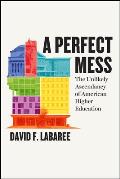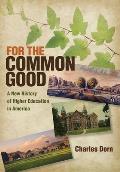- About
- Programs
- Issues
- Academic Freedom
- Political Attacks on Higher Education
- Resources on Collective Bargaining
- Shared Governance
- Campus Protests
- Faculty Compensation
- Racial Justice
- Diversity in Higher Ed
- Financial Crisis
- Privatization and OPMs
- Contingent Faculty Positions
- Tenure
- Workplace Issues
- Gender and Sexuality in Higher Ed
- Targeted Harassment
- Intellectual Property & Copyright
- Civility
- The Family and Medical Leave Act
- Pregnancy in the Academy
- Publications
- Data
- News
- Membership
- Chapters
American Higher Education Regained
A Perfect Mess: The Unlikely Ascendancy of American Higher Education by David F. Labaree. Chicago: University of Chicago Press, 2017.
For the Common Good: A New History Of Higher Education in America by Charles Dorn. Ithaca, NY: Cornell University Press, 2017.
In some sense, it is a shame that Professors Labaree (Stanford University) and Dorn (Bowdoin College) could not have teamed up, cross-country, to write a single, somewhat longer, book. They might have tempered each other’s claims and conclusions, reduced their respective shortcomings, and expanded their collective accomplishments.
Both combat the familiar notion that American higher education is in some kind of “crisis” and does not rate the high esteem it enjoys in the rest of the world. Both admit that the American higher educational “system” was historically jerry-built and is, and always has been, full of flaws structural and philosophical. But both conclude that while it is a bit of a “mess,” the system works reasonably well, if not perfectly, for its various constituents—students, faculty, alumni, and society. Labaree calls it a “perfect” mess, an unplanned structure “riddled with contradictions,” that works in spite of itself and constitutes “one of the all-time great institutional success stories.” And because “this ungainly system . . . is in fact doing just what we want it to,” he pleads, “we need to leave it alone” rather than tinker or make ambitious changes according to the latest ideology or panacea. Even Dorn, working from a different perspective and taking a different tack, is confident that America’s multipurpose colleges and universities will remain “the envy of the world” and will, like their early nineteenth-century originals, “foster the civic capability and commitment to the public good necessary for American democracy not to simply survive but to flourish for decades to come.”
Labaree and Dorn work from different evidential bases. Labaree builds a historical synthesis largely from the best secondary sources, which themselves, of course, are grounded in primary sources. In seeking to provide a new history focused on college and university pursuit of “the common good,” Dorn claims to have provided a “historical compass” for modern reformers by writing “the first comprehensive historical analysis of higher education published since [Lawrence] Veysey’s [1965 The Emergence of the American University] that is both thesis-driven and grounded in original archival research.” Not only does he seek to discredit Veysey’s work by gratuitously labeling him a “tattooed nudist” who lived out his last years in Hawaii; he builds his own much slimmer case on evidence from just eleven regionally distributed colleges and universities (out of the 4,700 extant), ranging from his own Bowdoin College in the Northeast to San Jose State University and Stanford (where he got his MA) in the West. Although he recognizes that these institutions are “illustrative only” and not “representative” of higher education “at any moment in time,” they are (he claims) “thoughtfully chosen,” cover the range of institutional types, and provide “instructive insight” into the larger American scene and history of higher education.
While some of Dorn’s evidence does depend on archival sources, his work is not as groundbreaking as he claims. He conveniently forgets Roger Geiger’s imposingly thorough The History of American Higher Education: Learning and Culture from the Founding to World War II (2015) and John Thelin’s weighty and witty first and second editions of A History of American Higher Education (2004, 2011). And since institutional mission statements are the primary sources for commitments to “the common good,” Dorn takes them at face value most of the time, without fully accounting for the powerful “social, political, and economic forces” that “push in an opposite direction,” particularly in our own age of student consumerism and pursuit of affluence, personal and institutional. At other times, he finds a way to make individual advancement into a common good—a hard sell unless differential graduation rates and educational indebtedness and default rates are ignored.
Today’s unplanned “system,” says Labaree, resulted from developments in four “tiers” or strata of institutions: (1) old colonial Ivies, (2) land-grant institutions such as agricultural and mechanical schools and state universities, (3) teachers colleges that grew from normal schools and in turn morphed into regional state or comprehensive universities, and (4) private liberal arts, junior or community, and religious colleges. Together, they extend opportunity at the bottom and protect socioeconomic privilege at the top: “Those most accessible provide the least social benefit,” while those “least accessible open the most doors.” This stratification, the lack of a national university, and the very large number of different institutions enable the system “to be all things to all people.”
The top three tiers converge around the research university model, which borrowed selected features from late-nineteenth-century German universities to put the “higher” in American education. By “adding the pinnacle while keeping the base,” the American system was able to offer a wide range of price tags and varying levels of prestige and academic rigor. Even many research universities became famous “party schools” when student (consumer) demand created powerful extracurricular or student cultures, often based on athletics. Ironically, when professional schools were added at the top, they soon became more scholarly and “liberal” by osmosis, while undergraduate curricula in the bottom tiers became more practical and preprofessional. Labaree draws four lessons from his historical tour: (1) “age trumps youth,” (2) “the strongest rewards go to those at the top of the system,” (3) “it pays to imitate your betters,” and (4) “it’s most prudent to expand the system by creating new colleges rather than increasing enrollments at existing colleges.”
Dorn treats only the latest two centuries of development and problematically substitutes “ethos” for institutional types or “tiers.” Each ethos, he claims, dominated its own period, “informing the character of institutional debates and telling the definitive story of its time.” “Practicality” dominated the antebellum and Civil War periods, “commercialism” ruled from Reconstruction to World War II, and “affluence” has prevailed ever since. In composing a picture of today’s system, he does treat all-male denominational colleges, agricultural and normal schools, women’s colleges, historically black institutions, research universities, and junior colleges, many of which merged or grew to become comprehensive institutions like Clark Kerr’s famous (or infamous) “multiversities.” Their multiple purposes, he argues, “may well be American higher education’s greatest strength,” particularly if singular attention to “civic-mindedness” or service to “the common good” is being subsumed by other more personal aims and goals. Still, Dorn remains confident that “even now, a dedication to the public good animates many college and university communities while motivating students, faculty, and administrators.” They will continue, he’s sure, to “produce more than just knowledge that contributes to the next great technological innovation or workforce that successfully competes in a global economy.”
While both books are worth reading, the presses that published them could have paid more thoughtful attention to their physical production. Cornell University Press’s tiny font makes Dorn’s text hard to digest. And his text would have benefited from more than one illustration per chapter, an early list of those illustrations, and much more evocative subjects to enhance and advance the argument. Dull photos of unreadable archival documents, old buildings, cornerstone layings, and promotional posters do precious little for the reader. Labaree’s University of Chicago Press book has no illustrations but a user-friendly font size. Both books are readable and stimulating. But Labaree, used to trying out his writings as lectures in his introductory course on American higher education at Stanford’s Graduate School of Education, carries over a conversational prose style full of personal guidance and elementary road directions that we can assume most Stanford graduate students do not require. Still, it should increase their (and other readers’) chances of doing well on the final exam, no mean feat for any book on the history of education.
James Axtell is the Kenan Professor of Humanities Emeritus at the College of William and Mary. He is the author or editor of nineteen books, including The Making of Princeton University: From Woodrow Wilson to the Present (2006) and Wisdom’s Workshop: The Rise of the Modern University (2016). His email address is [email protected].







